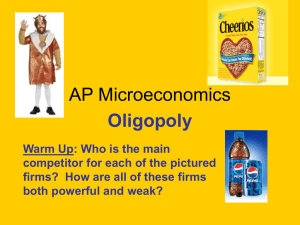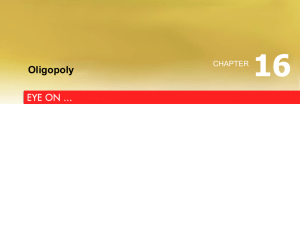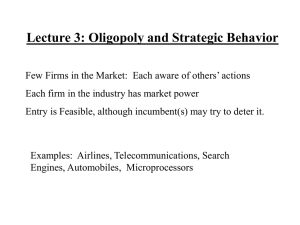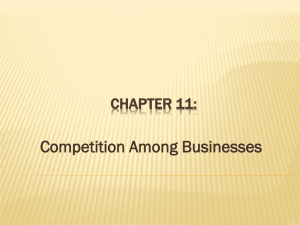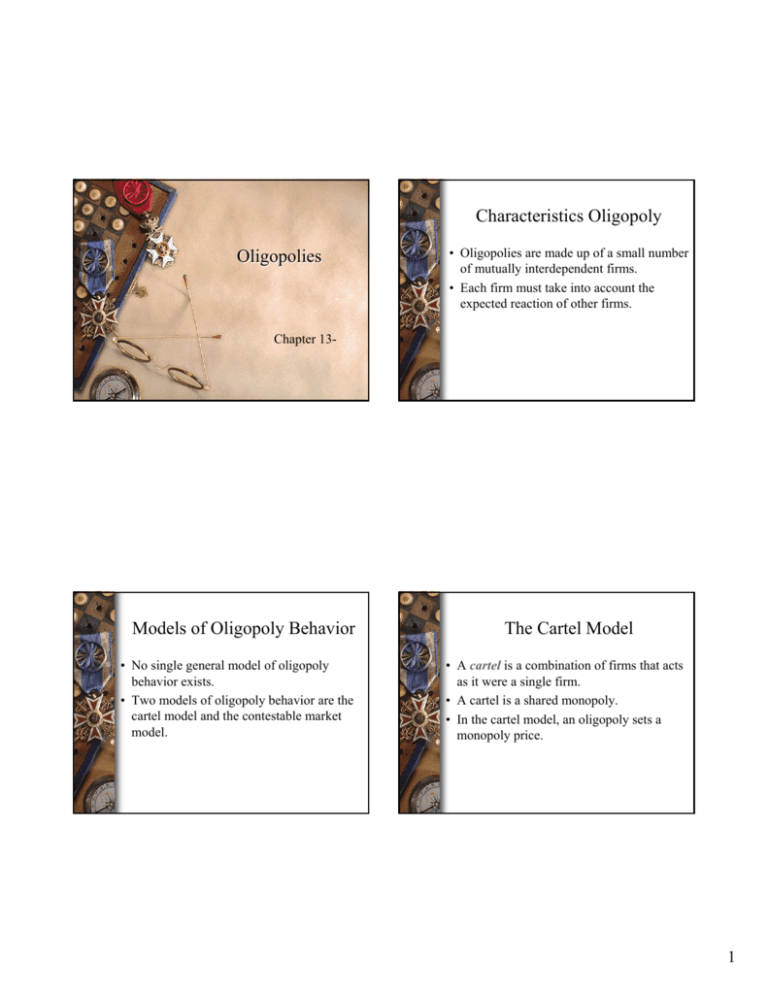
Characteristics Oligopoly
Oligopolies
• Oligopolies are made up of a small number
of mutually interdependent firms.
• Each firm must take into account the
expected reaction of other firms.
Chapter 13-
Models of Oligopoly Behavior
• No single general model of oligopoly
behavior exists.
• Two models of oligopoly behavior are the
cartel model and the contestable market
model.
The Cartel Model
• A cartel is a combination of firms that acts
as it were a single firm.
• A cartel is a shared monopoly.
• In the cartel model, an oligopoly sets a
monopoly price.
1
The Cartel Model
• If oligopolies can limit the entry of other
firms and form a cartel, they can increase
the profits going to the firms in the cartel.
Implicit Price Collusion
• Formal collusion is illegal in the U.S. while
informal collusion is permitted.
• Implicit price collusion exists when
multiple firms make the same pricing
decisions even though they have not
consulted with one another.
The Cartel Model
• The cartel model of oligopoly:
• Oligopolies act as if they were monopolists,
• That have assigned output quotas to individual
member firms,
• So that total output is consistent with joint
profit maximization.
Implicit Price Collusion
• Sometimes the largest or most dominant
firm takes the lead in setting prices and the
others follow.
2
Cartels and Technological
Change
• Cartels can be destroyed by an outsider with
technological superiority.
• Thus, cartels with high profits will provide
incentives for significant technological
change.
Why Are Prices Sticky?
• Informal collusion is an important reason
why prices are sticky.
• Another is the kinked demand curve.
Why Are Prices Sticky?
• When there is a kink in the demand curve,
there has to be a gap in the marginal
revenue curve.
• The kinked demand curve is not a theory of
oligopoly but a theory of sticky prices.
The Kinked Demand Curve
Price
a
P
b
MC0
c
MC1
D1
d
MR1
D2
0
Q
MR2
Quantity
3
The Contestable Market Model
• According to the contestable market model,
barriers to entry and barriers to exit
determine a firm’s price and output
decisions.
The Contestable Market Model
• In the contestable market model, an
oligopoly with no barriers to entry sets a
competitive price.
• Even if the industry contains only one firm, it
could still be a competitive market if entry is
open.
Comparing the Contestable
Market and Cartel Models
• The stronger the ability of oligopolists to
collude and prevent market entry, the closer
it is to a monopolistic situation.
• The weaker the ability to collude is, the
more competitive it is.
• Oligopoly markets lie between these two
extremes.
Strategic Pricing and Oligopoly
• Both the cartel and contestable market
models use strategic pricing decisions –
firms set their price based on the expected
reactions of other firms.
4
New Entry as a Limit on the
Cartelization Strategy
• The threat from outside competition limits
oligopolies from acting as a cartel.
• The newcomer may not want to cooperate
with the other firms.
Price Wars
• A firm may develop a predatory pricing
strategy as a matter of policy.
• A predatory pricing strategy involves
temporarily pushing the price down in order to
drive a competitor out of business.
Price Wars
• Price wars are the result of strategic pricing
decisions gone wild.
• Sometimes a firm engages in this activity
because it hates its competitor.
Game Theory and Strategic
Decision Making
• Most oligopolistic strategic decision making
is carried out with explicit or implicit use of
game theory.
• Game theory is the application of economic
principles to interdependent situations.
5
Game Theory and Strategic
Decision Making
Game Theory and Strategic
Decision Making
• The prisoner’s dilemma is a well-known
game that demonstrates the difficulty of
cooperative behavior in certain
circumstances.
• In the prisoner’s dilemma, where mutual
trust gets each one out of the dilemma,
confessing is the rational choice.
Prisoner’s Dilemma and a
Duopoly Example
Prisoner’s Dilemma and a
Duopoly Example
• The prisoners dilemma has its simplest
application when the oligopoly consists of
only two firms—a duopoly.
• By analyzing the strategies of both firms
under all situations, all possibilities are
placed in a payoff matrix.
• A payoff matrix is a box that contains the
outcomes of a strategic game under various
circumstances.
6
Firm and Industry Duopoly
Cooperative Equilibrium
$900
600
600
500
500
Price
400
300
100
100
0
0
3
4
5
6
7
8
Quantity (in thousands)
(a) Firm's cost curves
McGraw-Hill/Irwin
D
300
200
2
Competitive
solution
MC ATC
MC ATC
$800
400
200
1
MC
$800
800
700
700
700
600
550
500
600
550
500
600
550
500
A
400
300
A
400
Price
700
Monopolist
solution
Price
700
Price
$800
Price
MC ATC
$800
575
Firm and Industry Duopoly Equilibrium
When One Firm Cheats
300
200
200
100
100
C
B
A
NonCheating
400 cheating
firm’s
firm’s
output
300 output
200
MR
1
2
3
4
5
6
7
8
9 10 11
Quantity (in thousands)
(b) Industry: Competitive and monopolist solution
© 2004 The McGraw-Hill Companies, Inc., All Rights Reserved.
Duopoly and a Payoff Matrix
• The duopoly is a variation of the prisoner's
dilemma game.
• The results can be presented in a payoff
matrix that captures the essence of the
prisoner's dilemma.
0
1
2 3 4
0
5 6 7
Quantity (in thousands)
(a) Noncheating firm’s loss
100
1
2 3 4
5
0
6 7
Quantity (in thousands)
(b) Cheating firm’s profit
1
2 3
4 5 6
7 8
Quantity (in thousands)
(c) Cheating solution
© 2004 The McGraw-Hill Companies, Inc., All Rights Reserved.
McGraw-Hill/Irwin
The Payoff Matrix of Strategic
Pricing Duopoly
A Does not cheat
A Cheats
A +$200,000
A $75,000
B Does not
cheat
B $75,000
B – $75,000
A – $75,000
A0
B Cheats
B +$200,000
B0
7
Oligopoly Models, Structure, and
Performance
Oligopoly Models, Structure, and
Performance
• Oligopoly models are based either on
structure or performance.
• A monopoly is the least competitive,
perfectly competitive industries are the most
competitive.
• The four-fold division of markets considered so
far are based on market structure.
• Structure means the number, size, and
interrelationship of firms in the industry.
Oligopoly Models, Structure, and
Performance
• The contestable market model gives less
weight to market structure.
• Markets in this model are judged by performance,
not structure.
• Close relatives of it have previously been called
the barriers-to-entry model, the stay-out pricing
model, and the limited-pricing model.
Oligopoly Models, Structure, and
Performance
• There is a similarity in the two approaches.
• Often barriers to entry are the reason there are only
a few firms in an industry.
• When there are many firms, that suggests that
there are few barriers to entry.
• In the majority of cases, the two approaches come
to the same conclusion.
8


